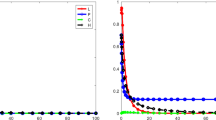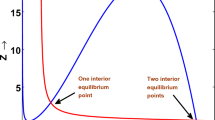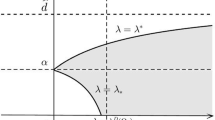Abstract
This paper is the first to propose an allelopathic phytoplankton competition ODE model influenced by the fear effect based on natural biological phenomena. It is shown that the interplay of this fear effect and the allelopathic term cause rich dynamics in the proposed competition model, such as global stability, transcritical bifurcation, pitchfork bifurcation, and saddle-node bifurcation. We also consider the spatially explicit version of the model and prove analogous results. Numerical simulations verify the feasibility of the theoretical analysis. The results demonstrate that the primary cause of the extinction of non-toxic species is the fear of toxic species compared to toxins. Allelopathy only affects the density of non-toxic species. The discussion guides the conservation of species and the maintenance of biodiversity.





















Similar content being viewed by others
References
Antwi-Fordjour, K., Parshad, R.D., Beauregard, M.A.: Dynamics of a predator-prey model with generalized Holling type functional response and mutual interference. Math. Biosci. 326, 108407 (2020)
Bodine, E.N., Capaldi, A.: Can culling barred owls save a declining northern spotted owl population? Nat. Resour. Model. 30(3), e12131 (2017)
Brown, J.S., Laundré, J.W., Gurung, M.: The ecology of fear: optimal foraging, game theory, and trophic interactions. J. Mammal. 80(2), 385–399 (1999)
Biswas, S., Tiwari, P.K., Pal, S.: Delay-induced chaos and its possible control in a seasonally forced eco-epidemiological model with fear effect and predator switching. Nonlinear Dyn. 104(3), 2901–2930 (2021)
Cantrell, R.S., Cosner, C.: Spatial Ecology via Reaction–Diffusion Equations. Wiley, Hoboken (2004)
Chen, F.: On a nonlinear nonautonomous predator–prey model with diffusion and distributed delay. J. Comput. Appl. Math. 180, 33–49 (2005)
Chesson, P., Kuang, J.J.: The interaction between predation and competition. Nature 456, 235–238 (2008)
Chen, F., Gong, X., Chen, W.: Extinction in two dimensional discrete Lotka–Volterra competitive system with the effect of toxic substances (II). Dyn. Contin. Discrete Impuls. Syst. Ser. B Appl. Algorithms 20, 449–461 (2013)
Chen, F., Chen, X., Huang, S.: Extinction of a two species non-autonomous competitive system with Beddington–DeAngelis functional response and the effect of toxic substances. Open Math. 14, 1157–1173 (2016)
Chen, S., Chen, F., Li, Z., Chen, L.: Bifurcation analysis of an allelopathic phytoplankton model. J. Biol. Syst. 31(03), 1063–1097 (2023)
Chen, S., Chen, F., Srivastava, V., Parshad, R.D.: Dynamical analysis of a Lotka–Volterra competition model with both Allee and fear effect. Int. J. Biomath. (2023). https://doi.org/10.13140/RG.2.2.33238.11843
Du, Y.: Effects of a degeneracy in the competition model: Part I. Classical and generalized steady-state solutions. J. Differ. Equ. 181(1), 92–132 (2002)
Du, Y.: Effects of a degeneracy in the competition model: Part II. Perturbation and dynamical behaviour. J. Differ. Equ. 181(1), 133–164 (2002)
Fistarol, G.O., Legrand, C., Rengefors, K., Granéli, E.: Temporary cyst formation in phytoplankton: A response to allelopathic competitors? Environ. Microbiol. 6(8), 791–798 (2004)
Gilbarg, D., Trudinger, N.S., Gilbarg, D., Trudinger, N.S.: Elliptic Partial Differential Equations of Second Order. Springer, Berlin (1977)
Gökçe, A.: A mathematical model of population dynamics revisited with fear factor, maturation delay, and spatial coefficients. Math. Methods Appl. Sci. 45(17), 11828–11848 (2022)
Gökçe, A.: Dynamical behaviour of a predator–prey system encapsulating the fear affecting death rate of prey and intra-specific competition: revisited in a fluctuating environment. J. Comput. Appl. Math. 421, 114849 (2023)
Henry, D.: Geometric Theory of Semilinear Parabolic Equations. Springer, Berlin (2006)
Kishimoto, K., Weinberger, H.F.: The spatial homogeneity of stable equilibria of some reaction–diffusion systems on convex domains. J. Differ. Equ. 58(1), 15–21 (1985)
Kaur, R.P., Sharma, A., Sharma, A.K.: Impact of fear effect on plankton-fish system dynamics incorporating zooplankton refuge. Chaos Solitons Fract. 143, 110563 (2021)
Lam, K.Y., Lou, Y.: Introduction to Reaction–Diffusion Equations: Theory and Applications to Spatial Ecology and Evolutionary Biology. Springer, Berlin (2022)
Legrand, C., Rengefors, K., Fistarol, G.O., Graneli, E.: Allelopathy in phytoplankton-biochemical, ecological and evolutionary aspects. Phycologia 42, 406–419 (2003)
Long, L.L., Wolfe, J.D.: Review of the effects of barred owls on spotted owls. J. Wildl. Manag. 83, 1281–1296 (2019)
Lai, L., Zhu, Z., Chen, F.: Stability and bifurcation in a predator–prey model with the additive Allee effect and the fear effect. Mathematics 8, 1280 (2020)
Liu, T., Chen, L., Chen, F., Li, Z.: Stability analysis of a Leslie–Gower model with strong Allee effect on prey and fear effect on predator. Int. J. Bifurc. Chaos 32, 2250082 (2022)
Maynard-Smith, J.: Models in Ecology. Cambridge University Press, Cambridge (1974)
Morgan, J.: Global existence for semilinear parabolic systems. SIAM J. Math. Anal. 20(5), 1128–1144 (1989)
Mulderij, G., Smolders, A.J., Van Donk, E.L.L.E.N.: Allelopathic effect of the aquatic macrophyte, Stratiotes aloides, on natural phytoplankton. Freshw. Biol. 51, 554–561 (2006)
Ma, Z., Zhou, Y., Li, C.: Qualitative and Stability Methods of Ordinary Differential Equations. Science Press, Beijing (2015)
Mandal, A., Biswas, S., Pal, S.: Toxicity-mediated regime shifts in a contaminated nutrient-plankton system. Chaos Interdiscip. J. Nonlinear Sci. 33(2), 023106 (2023)
Mandal, A., Sk, N., Biswas, S.: Nutrient enrichment and phytoplankton toxicity influence a diversity of complex dynamics in a fear-induced plankton-fish model. J. Theor. Biol. 578, 111698 (2024)
Mandal, A., Tiwari, P.K., Pal, S.: A nonautonomous model for the effects of refuge and additional food on the dynamics of phytoplankton–zooplankton system. Ecol. Complex. 46, 100927 (2021)
Parshad, R.D., Antwi-Fordjour, K., Takyi, E.M.: Some novel results in two species competition. SIAM J. Appl. Math. 81(5), 1847–1869 (2021)
Pierre, M.: Global existence in reaction–diffusion systems with control of mass: a survey. Milan J. Math. 78, 417–455 (2010)
Peckarsky, B.L., Abrams, P.A., Bolnick, D.I., Dill, L.M., Grabowski, J.H., Luttbeg, B., Trussell, G.C.: Revisiting the classics: considering nonconsumptive effects in textbook examples of predator-prey interactions. Ecology 89, 2416–2425 (2008)
Polis, G.A., Myers, C.A., Holt, R.D.: The ecology and evolution of intraguild predation: potential competitors that eat each other. Annu. Rev. Ecol. Syst. 20, 297–330 (1989)
Perko, L.: Differential Equations and Dynamical Systems. Springer, New York (2013)
Pradhan, B., Ki, J.S.: Phytoplankton toxins and their potential therapeutic applications: a journey toward the quest for potent pharmaceuticals. Mar. Drugs 20, 271 (2022)
Pringle, R.M., Kartzinel, T.R., Palmer, T.M., Thurman, T.J., Fox-Dobbs, K., Xu, C.C., et al.: Predator-induced collapse of niche structure and species coexistence. Nature 570, 58–64 (2019)
Sasmal, S.K., Takeuchi, Y.: Dynamics of a predator–prey system with fear and group defense. J. Math. Anal. Appl. 481(1), 123471 (2020)
Saswati, B., et al.: Modeling the avoidance behavior of zooplankton on phytoplankton infected by free viruses. J. Biol. Phys. 46, 1–31 (2020)
Srivastava, V., Takyi, E.M., Parshad, R.D.: The effect of “fear’’ on two species competition. Math. Biosci. Eng. 20, 8814–8855 (2023)
Srivastava, V., Van Lanen,N.J., Parshad, R.D.: Modeling competition co-occurrence effects between the invasive barred owl and imperiled northern spotted owl, In Preparation. (2024)
Taylor, F.J.R.: The biology of dinoflagellates. Bot. Monogr. 21, 723–731 (1987)
Van Lanen, N.J., Franklin, A.B., Huyvaert, K.P., Reiser, R.F., II., Carlson, P.C.: Who hits and hoots at whom? Potential for interference competition between barred and northern spotted owls. Biol. Conserv. 144, 2194–2201 (2011)
Wang, X., Walton, J.R., Parshad, R.D.: Stochastic models for the Trojan Y-Chromosome eradication strategy of an invasive species. J. Biol. Dyn. 10(1), 179–199 (2016)
Winder, M., Sommer, U.: Phytoplankton response to a changing climate. Hydrobiologia 698, 5–16 (2012)
Wiens, J.D., Anthony, R.G., Forsman, E.D.: Competitive interactions and resource partitioning between northern spotted owls and barred owls in western Oregon. Wildl. Monogr. 185, 1–50 (2014)
Wang, X., Zanette, L., Zou, X.: Modelling the fear effect in predator–prey interactions. J. Math. Biol. 73, 1179–1204 (2016)
Zhang, Z., Ding, T., Huang, W., Dong, Z.: Qualitative Theory of Differential Equation. Science Press, Beijing (1992)
Zhang, H., Cai, Y., Fu, S., Wang, W.: Impact of the fear effect in a prey–predator model incorporating a prey refuge. Appl. Math. Comput. 356, 328–337 (2019)
Author information
Authors and Affiliations
Corresponding author
Additional information
Publisher's Note
Springer Nature remains neutral with regard to jurisdictional claims in published maps and institutional affiliations.
Appendix A
Appendix A
Rights and permissions
Springer Nature or its licensor (e.g. a society or other partner) holds exclusive rights to this article under a publishing agreement with the author(s) or other rightsholder(s); author self-archiving of the accepted manuscript version of this article is solely governed by the terms of such publishing agreement and applicable law.
About this article
Cite this article
Chen, S., Chen, F., Srivastava, V. et al. Dynamical Analysis of an Allelopathic Phytoplankton Model with Fear Effect. Qual. Theory Dyn. Syst. 23, 189 (2024). https://doi.org/10.1007/s12346-024-01047-3
Received:
Accepted:
Published:
DOI: https://doi.org/10.1007/s12346-024-01047-3




